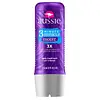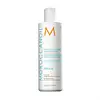What's inside
What's inside
 Key Ingredients
Key Ingredients

No key ingredients
 Benefits
Benefits

 Concerns
Concerns

 Ingredients Side-by-side
Ingredients Side-by-side

Water
Skin ConditioningCetearyl Alcohol
EmollientBehentrimonium Chloride
PreservativePPG-3 Benzyl Ether Myristate
EmollientStearamidopropyl Dimethylamine
EmulsifyingGlycerin
HumectantQuaternium-98
EmollientArgania Spinosa Kernel Oil
EmollientPersea Gratissima Oil
Skin ConditioningSimmondsia Chinensis Seed Oil
EmollientChamomilla Recutita Flower Extract
MaskingLavandula Angustifolia Flower Extract
CleansingRosmarinus Officinalis Leaf Extract
AntimicrobialHydrolyzed Vegetable Protein Pg-Propyl Silanetriol
Skin ConditioningSilk Amino Acids
HumectantHydrolyzed Keratin
HumectantKeratin Amino Acids
Skin ConditioningCellulose
AbsorbentHydroxyethylcellulose
Emulsion StabilisingPanthenol
Skin ConditioningCitric Acid
BufferingDimethicone
EmollientDimethiconol
EmollientLinoleamidopropyl Pg-Dimonium Chloride Phosphate Dimethicone
Polyquaternium-37
PPG-1 Trideceth-6
Skin ConditioningQuaternium-80
Caprylyl Glycol
EmollientPropylene Glycol
HumectantPropylene Glycol Dicaprylate/Dicaprate
EmollientAcrylates Copolymer
Disodium EDTA
Sodium PCA
HumectantParfum
MaskingGuar Hydroxypropyltrimonium Chloride
Skin ConditioningCinnamidopropyltrimonium Chloride
Polyacrylamidopropyltrimonium Chloride
Cetrimonium Chloride
AntimicrobialDehydroacetic Acid
PreservativeIsopropyl Alcohol
SolventSorbitan Oleate
EmulsifyingBenzyl Alcohol
PerfumingChlorphenesin
AntimicrobialPhenoxyethanol
PreservativePotassium Sorbate
PreservativeSodium Acetate
BufferingSodium Benzoate
MaskingCI 17200
Cosmetic ColorantCI 19140
Cosmetic ColorantAlpha-Isomethyl Ionone
PerfumingLinalool
PerfumingWater, Cetearyl Alcohol, Behentrimonium Chloride, PPG-3 Benzyl Ether Myristate, Stearamidopropyl Dimethylamine, Glycerin, Quaternium-98, Argania Spinosa Kernel Oil, Persea Gratissima Oil, Simmondsia Chinensis Seed Oil, Chamomilla Recutita Flower Extract, Lavandula Angustifolia Flower Extract, Rosmarinus Officinalis Leaf Extract, Hydrolyzed Vegetable Protein Pg-Propyl Silanetriol, Silk Amino Acids, Hydrolyzed Keratin, Keratin Amino Acids, Cellulose, Hydroxyethylcellulose, Panthenol, Citric Acid, Dimethicone, Dimethiconol, Linoleamidopropyl Pg-Dimonium Chloride Phosphate Dimethicone, Polyquaternium-37, PPG-1 Trideceth-6, Quaternium-80, Caprylyl Glycol, Propylene Glycol, Propylene Glycol Dicaprylate/Dicaprate, Acrylates Copolymer, Disodium EDTA, Sodium PCA, Parfum, Guar Hydroxypropyltrimonium Chloride, Cinnamidopropyltrimonium Chloride, Polyacrylamidopropyltrimonium Chloride, Cetrimonium Chloride, Dehydroacetic Acid, Isopropyl Alcohol, Sorbitan Oleate, Benzyl Alcohol, Chlorphenesin, Phenoxyethanol, Potassium Sorbate, Sodium Acetate, Sodium Benzoate, CI 17200, CI 19140, Alpha-Isomethyl Ionone, Linalool
Ingredients Explained
These ingredients are found in both products.
Ingredients higher up in an ingredient list are typically present in a larger amount.
Benzyl Alcohol is most commonly used as a preservative. It also has a subtle, sweet smell. Small amounts of Benzyl Alcohol is not irritating and safe to use in skincare products. Most Benzyl Alcohol is derived from fruits such as apricots.
Benzyl Alcohol has both antibacterial and antioxidant properties. These properties help lengthen the shelf life of products. Benzyl Alcohol is a solvent and helps dissolve other ingredients. It can also improve the texture and spreadability.
Alcohol comes in many different forms. Different types of alcohol will have different effects on skin. This ingredient is an astringent alcohol.
Using high concentrations of these alcohols are drying on the skin. They may strip away your skin's natural oils and even damage your skin barrier. Astringent alcohols may also irritate skin.
Other types of astringent alcohols include:
According to the National Rosacea Society based in the US, you should be mindful of products with these alcohols in the top half of ingredients.
Any type of sanitizing product will have high amounts of alcohol to help kill bacteria and viruses.
Learn more about Benzyl AlcoholParfum is a catch-all term for an ingredient or more that is used to give a scent to products.
Also called "fragrance", this ingredient can be a blend of hundreds of chemicals or plant oils. This means every product with "fragrance" or "parfum" in the ingredients list is a different mixture.
For instance, Habanolide is a proprietary trade name for a specific aroma chemical. When used as a fragrance ingredient in cosmetics, most aroma chemicals fall under the broad labeling category of “FRAGRANCE” or “PARFUM” according to EU and US regulations.
The term 'parfum' or 'fragrance' is not regulated in many countries. In many cases, it is up to the brand to define this term.
For instance, many brands choose to label themselves as "fragrance-free" because they are not using synthetic fragrances. However, their products may still contain ingredients such as essential oils that are considered a fragrance by INCI standards.
One example is Calendula flower extract. Calendula is an essential oil that still imparts a scent or 'fragrance'.
Depending on the blend, the ingredients in the mixture can cause allergies and sensitivities on the skin. Some ingredients that are known EU allergens include linalool and citronellol.
Parfum can also be used to mask or cover an unpleasant scent.
The bottom line is: not all fragrances/parfum/ingredients are created equally. If you are worried about fragrances, we recommend taking a closer look at an ingredient. And of course, we always recommend speaking with a professional.
Learn more about ParfumPersea Gratissima Oil is also known as avocado oil.
Avocado Oil has antioxidant properties. It is mostly made up of the glycerides of fatty acids. About 67% of these fatty acids is made up of oleic acid. Palmitic acid and linoleic acid are also present.
These fatty acids help hydrate and soften the skin. It may increase collagen content in the skin. Collagen helps keep your skin plump and firm. This ingredient helps reduce inflammation and has not shown to clog pores.
This ingredient may not be fungal-acne safe due to its high fatty acid content.
Avocados also have B vitamins, vitamin K, vitamin C, vitamin E, and potassium.
Learn more about Persea Gratissima OilThis oil comes from the seeds of the desert shrub called Jojoba. It is more commonly known as jojoba oil, a non-comedogenic oil.
Jojoba oil does not contain fragrance and has many fatty-acids, making it a great soothing ingredient.
It also contains Vitamin E, a great moisturizing ingredient. Vitamin E is also an antioxidant and protects your skin against oxidative damage.
This ingredient humectant properties, meaning it helps draw moisture from the air. This helps keep your skin hydrated.
While jojoba has antibacterial properties, it is only able to kill some strains of bacteria.
Studies also show it helps in wound healing. In fact, Indigenous cultures have used jojoba as a moisturizer and to help treat burns for centuries.
Fun fact: Jojoba oil similar to natural human skin sebum, so it has a great effect on dry skin. It is also promising with helping to regulate sebum production.
Due to its fatty acid content, Jojoba oil may not be fungal acne safe. We recommend speaking with a professional if you have any concerns.
Learn more about Simmondsia Chinensis Seed OilWe don't have a description for Stearamidopropyl Dimethylamine yet.
Water. It's the most common cosmetic ingredient of all. You'll usually see it at the top of ingredient lists, meaning that it makes up the largest part of the product.
So why is it so popular? Water most often acts as a solvent - this means that it helps dissolve other ingredients into the formulation.
You'll also recognize water as that liquid we all need to stay alive. If you see this, drink a glass of water. Stay hydrated!
Learn more about Water